46.2.4 User-assisted Detection of Devices
|
|
On the Equipment tab of the Navigator, click the button Start Manual UE Config. |
<TEMS Investigation install dir>\Application\ManualUEConfig.exe.On the Port Configuration tab you create an entry that is directly mapped to a COM port number on the PC.
The Device Configuration tab is the one most commonly used. It creates an entry for the device that can be reused independently of the actual COM port number used for the device.
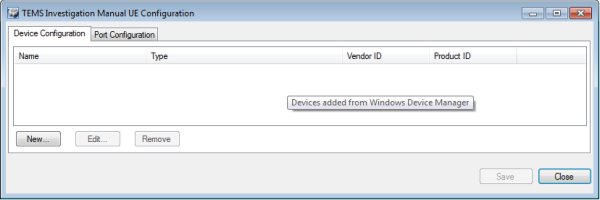
On the Device Configuration tab, click the New button to create a new entry. A dialog titled Select your device appears. In the tree view, select the device root node that contains the ports of interest. Then click OK.
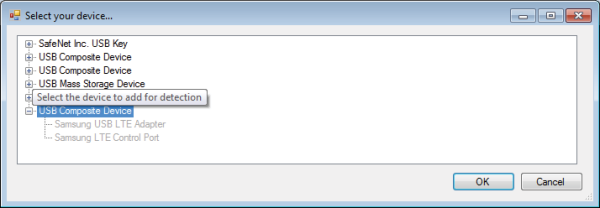
The Manage Device dialog appears. Select the type of device to use and map each available port on the device to its function. Ports that do not have a mapping can be left blank or undefined.
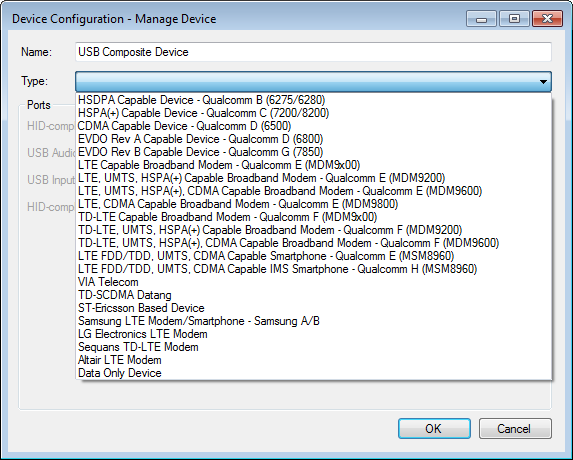
Under Name, enter a name for the device. (The string does not show anywhere else in TEMS Investigation.)
Under Type, choose the correct device type according to its capabilities.
In the Ports section, all ports of the device are listed. In the combo boxes on the right is indicated the functional assignment of each port in TEMS Investigation. You can change this assignment by modifying the selections in the combo boxes. See also sections "Mapping Device Ports to Interfaces"–"Data Service Testing with Arbitrary Devices".
Finally, click OK.
The device is added to the list in the main window. Click Save and Close.
|
|
Click the Refresh button in the Navigator. This is necessary to update TEMS Investigation with the device configuration just defined. (If you are running the Manual UE Configuration utility independently, TEMS Investigation will update itself automatically with this data when launched.) |

46.2.4.1. Mapping Device Ports to Interfaces
UEDescription.xml file (found under <TEMS Investigation install dir>\Application) may give an indication. The TYPE tag is mapped towards the interfaces, and the DESCRIPTION tag is the name displayed in the tool. (See the XML code excerpt below.)UEDescription.xml:|
Function |
Qualcomm |
LG |
Samsung |
|
Air Interface |
Diag:<...> |
LTE DM |
LTE DM |
|
Data Interface |
Data Modem |
– |
– |
|
AT Interface |
AT |
AT |
AT |
|
Ethernet Interface |
Ndis |
Ndis |
Ndis |
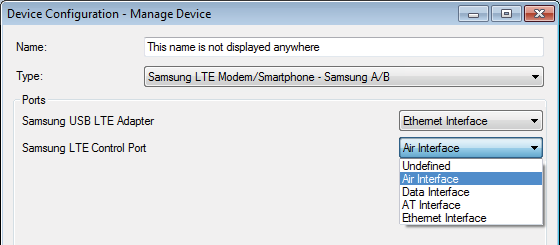
UEDescription.xml itself, entries like the following appear:<PRODUCT NAME="GT-B3710/GT-B3730/GT-B3740" PID="6889" FAMILY="SAMSUNG">
<DEVICE DESCRIPTION="Samsung USB LTE Adapter" SETUPCLASS="Net" TYPE="Ndis" />
<DEVICE DESCRIPTION="Samsung LTE Control Port" SETUPCLASS="Ports" TYPE="AT"/>
</PRODUCT>
46.2.4.2. Qualcomm Devices with NR 5G Capability
Launch the Manual UE Configuration utility and select your device as described in the introduction of section "User-assisted Detection of Devices".
In the Manage Device dialog, do as follows. Under Type, select NR 5G, LTE Dual Modem - Qualcomm M (SM8150/x50). Then, in the Ports section, pair each available port to the correct port type as shown in the screenshot below. Finally, click OK.
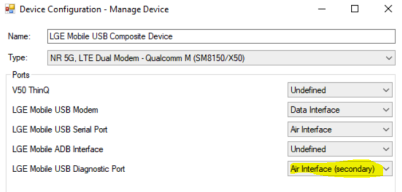
The device is added to the list in the main dialog window. Click Save and then Close.
46.2.4.3. Qualcomm Devices with LTE/TD-LTE Capability
Launch the Manual UE Configuration utility and select your device as described in the introduction of section "User-assisted Detection of Devices".
In the Manage Device dialog, do as follows. Under Type, select the appropriate chipset family. Then, in the Ports section, pair each available port to the correct port type as shown in the screenshot below. Finally, click OK.
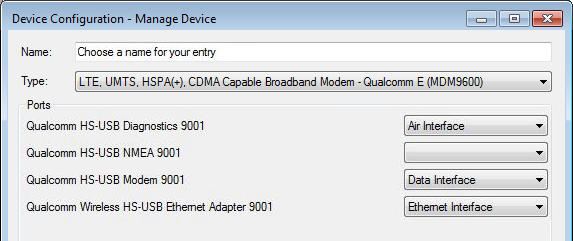
The device is added to the list in the main dialog window. Click Save and then Close.
46.2.4.4. Samsung Devices with LTE Capability
Launch the Manual UE Configuration utility and select your device as described in the introduction of section "User-assisted Detection of Devices".
For a Samsung device, set Type to "Samsung LTE Modem/Smartphone ...". Under Ports, assign the port named "Samsung USB LTE Adapter" to the "Ethernet Interface" function. If the device has a "Samsung LTE Control Port" that answers to AT commands, assign that port to "AT Interface".
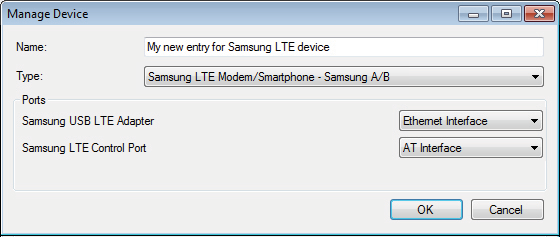
The device is added to the list in the main dialog window. Click Save and then Close.
46.2.4.5. Data Service Testing with Arbitrary Devices
If you want to use a device that is not officially supported, set Type to "Data Only Device" in the Manage Device dialog.
Map the device ports as appropriate. Below is an example.



